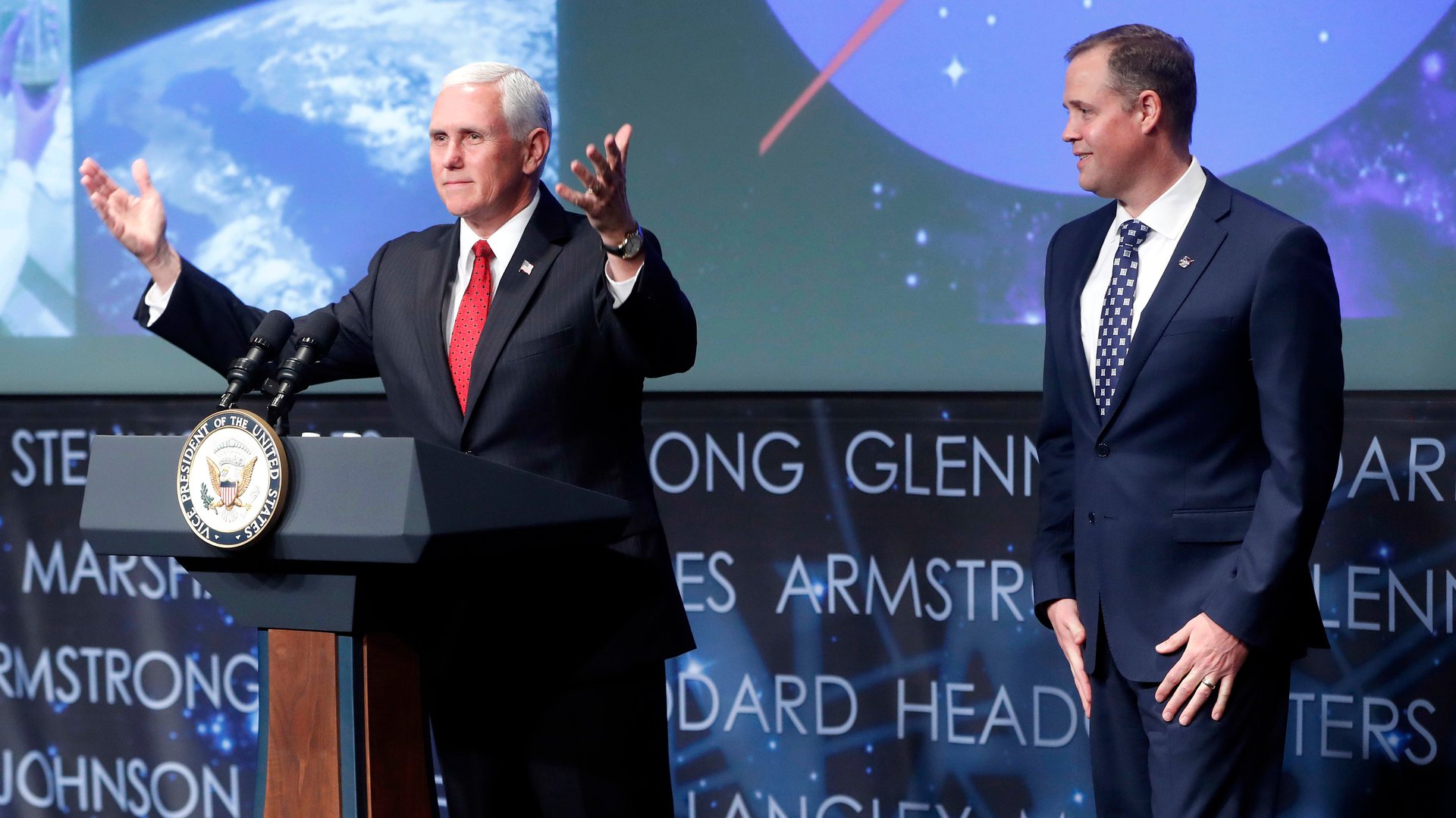How fast can NASA get humans back to the moon?
Vice President Mike Pence is expected to call on NASA to accelerate its plans to send humans back to the moon today (March 26).


Vice President Mike Pence is expected to call on NASA to accelerate its plans to send humans back to the moon today (March 26).
NASA and industry sources expected Pence, who leads White House space policy, to set a goal of returning astronauts to the lunar surface in 2024 at a National Space Council meeting in Huntsville, Alabama.
That aim would require NASA to accelerate its work to complete several complex hardware systems—including an orbiting lunar gateway, space suits, and a lander—that it does not have. It would require new funding or program changes requiring the support of Congress, which has proven eager to boost NASA’s budget in recent years but has ignored the Trump administration’s spending priorities.
NASA has aimed to return astronauts to the lunar surface by 2028 as part of a campaign that would eventually prepare humans to visit Mars. The 2028 date was likely to slip as the vehicles needed to get to the moon continue to face expensive delays. A first test mission combining the Space Launch System, a huge rocket being built by Boeing, and Lockheed Martin’s Orion space capsule, expected last year, has been delayed to at least 2021.
Now, the administration wants more urgency. So do lunar scientists eager to return to the Earth’s nearest neighbor to investigate lunar geology and to plumb the mysteries of the solar system with radio telescopes placed on the moon. The discovery of deposits of frozen ice have spurred dreams of resource extraction, and Chinese exploration missions have created geopolitical reasons to return. New space companies like Elon Musk’s SpaceX and Jeff Bezos’ Blue Origin, along with a crowd of startups trailing in their wake, see money to be made in the lunar economy of the future.
“This is not the situation that we were talking about in the early 60s, with [president John F. Kennedy] setting a goal to get to the moon in eight years—we had no technology,” said Jack Burns, a University of Colorado astrophysicist who works closely with the US space agency.
“We have all the technology that we need to develop this, we’ve got partnerships with industry, academic partnerships…international partners that are also very far along,” Burns says. “With both unmanned and human astronauts it is quite doable by the middle of the decade. But we have to put our shoulder to the wheel and really push, and that includes adequate resources to be able to do this as well.”
It’s not clear if the White House is prepared to make the case to Congress for more funding or if it is more focused on the political benefits of space exploration ahead of Donald Trump’s 2020 re-election campaign. This isn’t the first time NASA has considered rushing a project to please the White House; an early request to put humans on a test mission of SLS and Orion was denied after NASA said it would cost an additional $600 million to $900 million.
NASA administrator James Bridenstine insists the US is not in a race to the moon and that it would not make sense to invest in one-off missions at the expense of long-term sustainability. “We can prove that we can get to the moon faster than anyone else,” he told Quartz in December 2018. “That race is over. We won. Now it’s time to build a sustainable architecture…what we don’t want to do is recreate Apollo and then not go back for 50 years.”
When the space agency unveiled its 2020 budget request earlier this month, it remained focused on the 2028 timeline for human exploration. The agency did ask for additional funding to hire private companies to carry scientific instruments to the moon. Those robotic explorers are intended to pave the way for future human exploration, but the first missions are unlikely to begin until 2021.
The agency also asked for funding for its proposed lunar gateway, a kind of way station for astronauts to transition to the surface, and to develop a vehicle to carry humans down to the surface of the moon. These, along with the development of a space suit to protect humans exploring the lunar surface, would need to be stood up, funded, and completed before 2024. Bridenstine will speak to NASA’s funding committee about the agency’s budget needs tomorrow (March 27).
It’s not clear that NASA can push through big program changes needed to make that deadline. Under Bridenstine, NASA has begun to push harder on Boeing’s delayed SLS rocket program, threatening this month to replace it with commercial alternatives and requesting that Congress cancel investments in future upgrades until the first rocket is complete. But the day after he made those statements, he also issued a statement committing the space agency to build the rocket.
That bit of damage control reflects the political popularity of Boeing’s big-ticket project in Congress, where the defense contractor’s lobbying and creation of high-tech jobs remains influential.
Though the upcoming 50th anniversary of the first Apollo moon landing adds some varnish to the project, lawmakers are likely to ask why additional spending or shifts in focus are necessary to put people back on the moon. NASA’s other scientific efforts, from satellites that study Earth and climate science to space probes and telescopes to the International Space Station, all vie for taxpayer dollars, and cheaper robotic exploration missions may seem more attractive.
Still, experts argue that robots versus humans exploring the moon is not an either-or-question, with Burns describing his vision of “an astronaut commanding a team of rovers and robots that are working hand in hand. There is still no substitution for a scientist on the surface when it comes to field geology.”
Correction: An earlier version of this piece misreported NASA’s budget request, which included funds for a lunar lander.